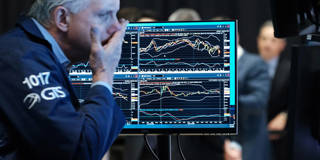There is ample reason to worry that major economies like the United States are heading for a recession, accompanied by cascading financial turmoil. Some of the worst elements of both the 1970s and the 2008 crash are now in play, with equity markets likely to move deeper into bear territory.
NEW YORK – The global financial and economic outlook for the year ahead has soured rapidly in recent months, with policymakers, investors, and households now asking how much they should revise their expectations, and for how long. That depends on the answers to six questions.
First, will the rise in inflation in most advanced economies be temporary or more persistent? This debate has raged for the past year, but now it is largely settled: “Team Persistent” won, and “Team Transitory” – which previously included most central banks and fiscal authorities – must admit to having been mistaken.
The second question is whether the increase in inflation was driven more by excessive aggregate demand (loose monetary, credit, and fiscal policies) or by stagflationary negative aggregate supply shocks (including the initial COVID-19 lockdowns, supply-chain bottlenecks, a reduced US labor supply, the impact of Russia’s war in Ukraine on commodity prices, and China’s “zero-COVID” policy). While both demand and supply factors were in the mix, it is now widely recognized that supply factors have played an increasingly decisive role. This matters because supply-driven inflation is stagflationary and thus raises the risk of a hard landing (increased unemployment and potentially a recession) when monetary policy is tightened.

NEW YORK – The global financial and economic outlook for the year ahead has soured rapidly in recent months, with policymakers, investors, and households now asking how much they should revise their expectations, and for how long. That depends on the answers to six questions.
First, will the rise in inflation in most advanced economies be temporary or more persistent? This debate has raged for the past year, but now it is largely settled: “Team Persistent” won, and “Team Transitory” – which previously included most central banks and fiscal authorities – must admit to having been mistaken.
The second question is whether the increase in inflation was driven more by excessive aggregate demand (loose monetary, credit, and fiscal policies) or by stagflationary negative aggregate supply shocks (including the initial COVID-19 lockdowns, supply-chain bottlenecks, a reduced US labor supply, the impact of Russia’s war in Ukraine on commodity prices, and China’s “zero-COVID” policy). While both demand and supply factors were in the mix, it is now widely recognized that supply factors have played an increasingly decisive role. This matters because supply-driven inflation is stagflationary and thus raises the risk of a hard landing (increased unemployment and potentially a recession) when monetary policy is tightened.